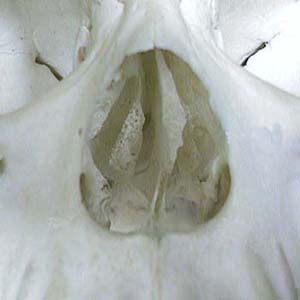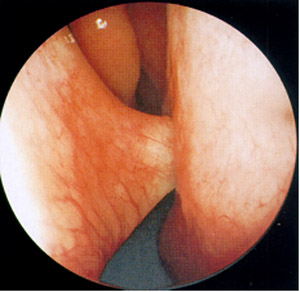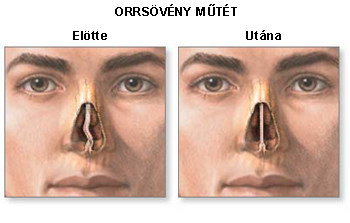Septal deviation
 The nose is the most protruding part of the body, and as such it contributes the most to defining the characteristics of individual faces.
The nose is the most protruding part of the body, and as such it contributes the most to defining the characteristics of individual faces.
The nose is divided into two equal parts by the septum, which parts the incoming air two ways and directs it past the nasal conchae and towards the maxillary sinuses and the nasopharynx.
Normally, the air flows evenly and laminally, i.e. on either side of the septum, into the nasal cavity. This flow of air guarantees that air prepared, humidified, warmed up and filtered before it enters the maxillary sinuses and the tympanic cavity (in the middle ear).
Only very few people have a perfectly straight septum. The septum might have bigger or smaller curves, growths or pricks.
As long as these are small and do not interfere with breathing through the nose, they are not regarded as pathological.
 In most cases, however, disfigurations can lead to consequential impairment. A deviated septum changes the course of air, making it turbulent, which, in turn, constantly irritates the mucous membrane of the nasal cavity, the maxillary sinuses, and the nasopharynx.
In most cases, however, disfigurations can lead to consequential impairment. A deviated septum changes the course of air, making it turbulent, which, in turn, constantly irritates the mucous membrane of the nasal cavity, the maxillary sinuses, and the nasopharynx.
Due to the constant irritation, the mucous membrane swells and narrows the orifices of the nose, maxillary sinuses, and the Eustachian tube. This can cause pathological processes in the sinuses and the middle ear.
Septal deviation develops during the person’s growth, due to the difference in the rate of growth between the bony vs. the cartilaginoid parts of the nasal septum.
Septal deviation usually develops starting from the age of 7, the time when permanent teeth start to erupt and the jawbone develops. The teeth and the facial part of the skull reach their final form at the age of 20-25. Septal deviation can occasionally be found in small children, age 3-4, or very rarely in infants.
Septal deviation can also result from trauma such as fracture of the facial part of the skull, the nose or the nasal septum. These can result in deviation, the formation of pricks or slats, all of which negatively affect communication through the nasal cavity. Septal deviation is often caused by unnoticed minor childhood injuries which trigger deviation of the septum much later, when the cause is long forgotten.
Deviation can develop in any part of the septum, although it is relatively rare in the dorsal, bony part of it. The septum might deviate only to one side, or to both sides in the shape of the letter S.
 Septal deviation results in blocking of the breathing, usually unilaterally, sometimes variably. The patient feels a blocking in the nose, and often their sense of smell is disturbed.
Septal deviation results in blocking of the breathing, usually unilaterally, sometimes variably. The patient feels a blocking in the nose, and often their sense of smell is disturbed.
If the deviation develops slowly and gradually, the patient does not feel that their breathing gets blocked since they gradually get used to it and the blockage becomes “natural”. In such cases it is problems that develop as a result of the condition that lead to the discovery of the original problem.
Such problems developing as a consequence can be headache, maxillary sinusitis due to blocked breathing, ear problems, pharynx problems, hysteric globus, recurrent nose bleeds, snoring etc. Pricks that grow out of the septum might sometimes reach the nasal conchae and pierce them.
This pathological connection gets stronger in case of concurrent conditions involving the swelling of the mucous membrane. Symptoms might grow exponentially if septal deviation is combined with other diseases. For instance, if nasal blocking due to allergy is combined with septal deviation, the sense of blockage and fullness is increased, as is the susceptibility to the development of maxillary sinusitis and polyp formation.
 The blocked nasal breathing due to septal deviation has a negative effect on the Eustachian tube as well. Recurrent or chronic ear problems are also sometimes due to septal deviation, so the treatment of the nasal condition is imperative before the treatment of the ear.
The blocked nasal breathing due to septal deviation has a negative effect on the Eustachian tube as well. Recurrent or chronic ear problems are also sometimes due to septal deviation, so the treatment of the nasal condition is imperative before the treatment of the ear.
Diagnosis can often be aided by visible details, e.g. when the end of the nasal septum protrudes from the nostril.
Diagnosis of cases not visible are aided by endoscopy. A CT scan is required, however, for an estimation of the details of the case and the state of the accessory sinuses.
 The solution of the condition is surgical: the bone and cartilage of the nasal septum have to be straightened out. Most surgical corrections of septal deviation are carried out in local anesthesia after a careful preparation of the patient.
The solution of the condition is surgical: the bone and cartilage of the nasal septum have to be straightened out. Most surgical corrections of septal deviation are carried out in local anesthesia after a careful preparation of the patient.
Contrary to widespread belief, the procedure is pain free if carried out by an experienced surgeon. However, patients have to prepare for two unpleasant details in connection with the operation.
One is that patients hear an unpleasant but painless breaking noise during the procedure. The other one is that the nose has to be plugged after the surgery, which causes a blockage in breathing.
The presence of the plug in the nostril is not painful, only unpleasant, causing watering in the eyes. Removal of the plug serves as the basis of many horror stories – these are, however, also unfounded, since the plug which has absorbed nasal discharge in the course of a few days can be removed gently and their removal causes relief for the patient.
In the weeks following the surgery the nose is still often blocked due to the swollen mucous membrane, the dried nasal discharge and the wound discharge. The cilium covering the mucous membrane also requires time to regenerate. Regular post-surgical checkups are important to avoid incorrect closing of tissues and complications.
Accesări: 13351





